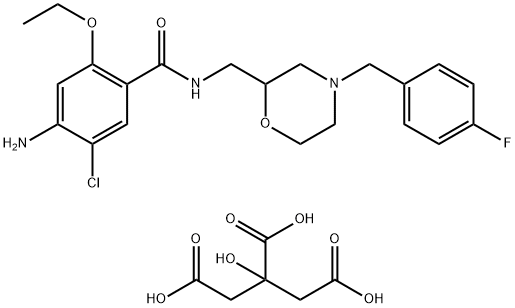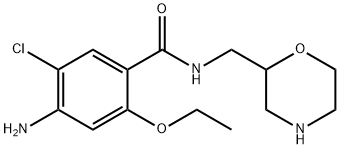Mosapride citrate
- CAS NO.:112885-42-4
- Empirical Formula: C27H33ClFN3O10
- Molecular Weight: 614.02
- MDL number: MFCD00874415
- EINECS: 601-211-6
- SAFETY DATA SHEET (SDS)
- Update Date: 2023-06-30 15:45:59

What is Mosapride citrate?
Description
Mosapride is an agonist of the serotonin (5-HT) receptor subtype 5-HT4 (Ki = 69.9 nM). It is selective for 5-HT4 over 5-HT1, 5-HT2, dopamine D2, and α1- and α2-adrenergic receptors but acts as a partial antagonist at 5-HT3 (Ki = 1,189 nM). It induces relaxation of precontracted rat esophageal thoracic muscularis mucosa preparations and enhances electrically evoked contractions in isolated guinea pig ileum (EC50s = 208.4 and 73.2 nM, respectively). Mosapride (0.5 and 1 mg/kg, i.v.) increases antral and duodenal, but not ileal or colonic, motility in conscious dogs. It also increases gastric emptying in rats when administered at doses ranging from 0.03 to 30 mg/kg.
The Uses of Mosapride citrate
As a selective SR-4 activator and a SR-3 inhibitor, Mosapride(Mosapride citrate) is a gastroprokinetic agent that acts as a selective 5HT4 agonist which accelerates gastric emptying and is used for the treatment of acid reflux, irritable bowel syndrome and functional dyspepsia.
The Uses of Mosapride citrate
Mosapride Citrate is a selective SR-4 activator and a SR-3 inhibitor.
What are the applications of Application
Mosapride citrate is a selective SR-4 activator and a SR-3 inhibitor
Biological Activity
5-HT 4 receptor agonist and 5-HT 3 receptor antagonist. Displays no activity at D 2 , α 1 , α 2 , 5-HT 1 and 5-HT 2 receptors. Gastroprokinetic agent; increases gastric emptying in rats and stimulates gastric motor actvity in conscious dogs.
storage
room temperature (desiccate)
Properties of Mosapride citrate
| Melting point: | 143-145° |
| storage temp. | Inert atmosphere,2-8°C |
| solubility | DMSO (Slightly), Ethanol (Slightly, Sonicated) |
| form | Solid |
| color | White to Off-White |
| Stability: | Hygroscopic |
| CAS DataBase Reference | 112885-42-4(CAS DataBase Reference) |
Safety information for Mosapride citrate
| Signal word | Warning |
| Pictogram(s) |
 Exclamation Mark Irritant GHS07 |
| GHS Hazard Statements |
H302:Acute toxicity,oral H315:Skin corrosion/irritation H319:Serious eye damage/eye irritation H332:Acute toxicity,inhalation H335:Specific target organ toxicity, single exposure;Respiratory tract irritation |
| Precautionary Statement Codes |
P280:Wear protective gloves/protective clothing/eye protection/face protection. P310:Immediately call a POISON CENTER or doctor/physician. P305+P351+P338:IF IN EYES: Rinse cautiously with water for several minutes. Remove contact lenses, if present and easy to do. Continuerinsing. |
Computed Descriptors for Mosapride citrate
Mosapride citrate manufacturer
New Products
(S)-3-Aminobutanenitrile hydrochloride 4-Methylphenylacetic acid N-Boc-D-alaninol N-BOC-D/L-ALANINOL Tert-butyl bis(2-chloroethyl)carbamate 3-Morpholino-1-(4-nitrophenyl)-5,6-dihydropyridin- 2(1H)-one Furan-2,5-Dicarboxylic Acid Tropic acid 1-Bromo-3,5-Di-Tert-Butylbenzene S-2-CHLORO PROPIONIC ACID ETHYL ISOCYANOACETATE 2-Bromo-1,3-Bis(Dimethylamino)Trimethinium Hexafluorophosphate 4-IODO BENZOIC ACID 3-NITRO-2-METHYL ANILINE 1-(2,4-DICHLOROPHENYL) ETHANAMINE (2-Hydroxyphenyl)acetonitrile 4-Bromopyrazole 2-(Cyanocyclohexyl)acetic acid 4-methoxy-3,5-dinitropyridine 1-(4-(aminomethyl)benzyl)urea hydrochloride 2-aminopropyl benzoate hydrochloride diethyl 2-(2-((tertbutoxycarbonyl)amino) ethyl)malonate tert-butyl 4- (ureidomethyl)benzylcarbamate Ethyl-2-chloro((4-methoxyphenyl)hydrazono)acetateRelated products of tetrahydrofuran








You may like
-
 112885-42-4 Mosapride citrate 98%View Details
112885-42-4 Mosapride citrate 98%View Details
112885-42-4 -
 Mosapride citrate 98% (HPLC) CAS 112885-42-4View Details
Mosapride citrate 98% (HPLC) CAS 112885-42-4View Details
112885-42-4 -
 1975-50-4 98%View Details
1975-50-4 98%View Details
1975-50-4 -
 2-HYDROXY BENZYL ALCOHOL 98%View Details
2-HYDROXY BENZYL ALCOHOL 98%View Details
90-01-7 -
 2-Chloro-1,3-Bis(Dimethylamino)Trimethinium Hexafluorophosphate 221615-75-4 98%View Details
2-Chloro-1,3-Bis(Dimethylamino)Trimethinium Hexafluorophosphate 221615-75-4 98%View Details
221615-75-4 -
 61397-56-6 CIS BROMO BENZOATE 98%View Details
61397-56-6 CIS BROMO BENZOATE 98%View Details
61397-56-6 -
 14714-50-2 (2-Hydroxyphenyl)acetonitrile 98+View Details
14714-50-2 (2-Hydroxyphenyl)acetonitrile 98+View Details
14714-50-2 -
 118753-70-1 98+View Details
118753-70-1 98+View Details
118753-70-1